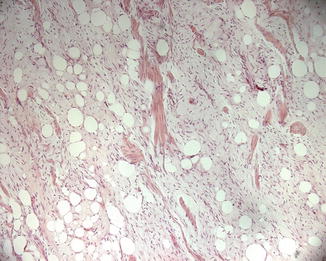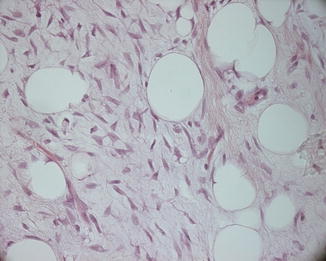Fig. 40.1
Spindle cell liposarcoma. The neoplasm is composed of a spindle cell bland neural-like proliferation arranged in fascicles and whorls set in a fibromyxoid stroma

Fig. 40.2
A spindle cell bland neural-like proliferation

Fig. 40.3
Spindle cells with blunt atypia

Fig. 40.4
Spindle cells associated with atypical adipocytes and lipoblasts
Incisional biopsy is not indicated in large adipose tumors as malignant degeneration is usually at the center of the mass, and malignant features can be missed, leading to inappropriate treatment.
Genetically, well-differentiated liposarcomas are characterized by the presence of a supernumerary ring or giant chromosomes containing amplified material from chromosome 12q14–q15, which includes the MDM2 and CDK4 genes. However, SCL tends to lack the amplification of MDM2 and/or CDK4, differently from the other subtypes of well-differentiated liposarcoma. Recently, a partial or complete monosomy of chromosome 7 and a deletion of the Rb-1 gene in the long arm of chromosome 13 without mutations of chromosome 12q region have been identified as other molecular cytogenetic characterization.
Differential Diagnosis
The main differential diagnoses are diffuse spindle cell lipoma (composed of bland, sometimes palisading, CD34-positive spindle cells, admixed with eosinophilic refractile collagen bundles and presenting the Rb-1 deletion) and neurofibroma (characterized by a less cellular S-100-positive spindle cell proliferation with wavy nuclei). Other differential diagnoses are dermatofibrosarcoma protuberans, low-grade malignant peripheral nerve sheath tumor, low-grade sarcoma, low-grade myxofibrosarcoma, dedifferentiated liposarcoma, and the other variants of well-differentiated liposarcoma, such as sclerosing liposarcoma. Low-grade dedifferentiated liposarcoma contains dedifferentiated areas that are generally non-lipogenic, whereas SCL contains well-differentiated atypical adipocytes or lipoblasts, although sometimes they may dedifferentiate forming non-lipogenic areas.
Stay updated, free articles. Join our Telegram channel

Full access? Get Clinical Tree








